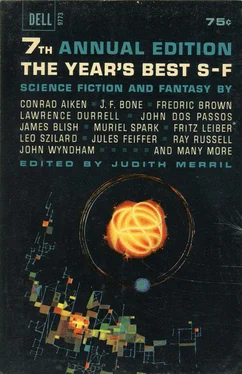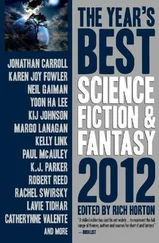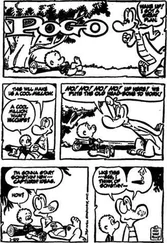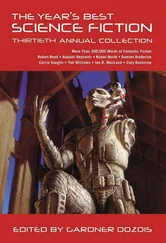Judith Merril - The Year's Best Science Fiction & Fantasy 7
Здесь есть возможность читать онлайн «Judith Merril - The Year's Best Science Fiction & Fantasy 7» весь текст электронной книги совершенно бесплатно (целиком полную версию без сокращений). В некоторых случаях можно слушать аудио, скачать через торрент в формате fb2 и присутствует краткое содержание. Год выпуска: 1963, Издательство: Dell, Жанр: Фантастика и фэнтези, на английском языке. Описание произведения, (предисловие) а так же отзывы посетителей доступны на портале библиотеки ЛибКат.
- Название:The Year's Best Science Fiction & Fantasy 7
- Автор:
- Издательство:Dell
- Жанр:
- Год:1963
- ISBN:нет данных
- Рейтинг книги:4 / 5. Голосов: 1
-
Избранное:Добавить в избранное
- Отзывы:
-
Ваша оценка:
- 80
- 1
- 2
- 3
- 4
- 5
The Year's Best Science Fiction & Fantasy 7: краткое содержание, описание и аннотация
Предлагаем к чтению аннотацию, описание, краткое содержание или предисловие (зависит от того, что написал сам автор книги «The Year's Best Science Fiction & Fantasy 7»). Если вы не нашли необходимую информацию о книге — напишите в комментариях, мы постараемся отыскать её.
The Year's Best Science Fiction & Fantasy 7 — читать онлайн бесплатно полную книгу (весь текст) целиком
Ниже представлен текст книги, разбитый по страницам. Система сохранения места последней прочитанной страницы, позволяет с удобством читать онлайн бесплатно книгу «The Year's Best Science Fiction & Fantasy 7», без необходимости каждый раз заново искать на чём Вы остановились. Поставьте закладку, и сможете в любой момент перейти на страницу, на которой закончили чтение.
Интервал:
Закладка:
“Who are you talking to?” asked Seymore. “You got more lobsters up there?”
“You go sit on the bed,” I ordered. “I’m going to bring the picture down with its back toward you. The way you do, for your rich clients.”
I found a place where the light was good, and slowly turned the picture around. Seymore jumped to his feet and whistled loudly.
“Boy!” he cried. “You’ve sure got something there. And the best period, too. Why, you can get up in the five figures for that, maybe more. Even after my commission. You going to Mr. Stettheimer’s party next week?”
“Yes.”
“Well, fella, I’ll have a nice check for you. By the way, what’s the title?” He picked up the picture and examined the back. “Why, yes, here it is. Very faint, in pencil. And in Pollock’s handwriting, too. It’s a funny title.”
“What is the title, Seymore?”
“Immediately Yours.”
“It’s not so funny,” I said.
Toward the end of the week Zogstein, my neighbor, went off to California. He had said I could borrow his jeep whenever I wanted. So the night of Mr. Stettheimer’s party I drove through Springs, past the broken tree where Pollock was killed, over to the Montauk highway. Mr. Stettheimer’s place is way out, opposite the airport. You take a private road through a thick woods, this opens up into an enormous lawn, and across that, on the edge of Georgica Lake, is the house. It’s all glass and about half a block long; it was designed by Philip Johnson or somebody. It was late, and there were lots of cars parked around. They were well beaten up and had a lot of character, the kind the artists like. I recognized most of them. This was a very exclusive party. But Seymore Harris’ red Jaguar was not there.
Mr. Stettheimer greeted me warmly. He was about eighty years old, I guess, but still frisky and alert. He was a banker, I knew, but except for his little gold-rimmed glasses, it was hard to believe. A long Peruvian serape covered his fat little body; beneath it a pair of faded bathing trunks hung down to his withered knees. He dressed that way because he wanted his guests to feel at home, he wanted to be inconspicuous. And actually, the way the artists dressed, he was. He led me through an enormous hall, hung with abstract pictures frame-to-frame, out onto a terrace overlooking the lake.
There were lots of people talking and dancing. Moving among them were a number of caterers in faultless evening dress carrying trays and glasses. The general effect was as if the peasants had revolted and pressed the nobles into service.
“Where’s Olivia?” Mr. Stettheimer asked, and produced an electric hearing machine from under his serape and held it toward me.
I rather hated to tell him, because he’d been so nice to me. “She ran off with Virgil,” I said. ‘The poet who lived upstairs.”
“Oh, dear me,” he said. “I warned Mrs. Stettheimer that something like that might happen. Oh, dear me. You’d better have a drink.”
He led me through the crowd to a table loaded with food and liquor. I held up my glass to Mr. Stettheimer, and he held up his hearing aid.
“What’s new in the art world?” I asked.
“Nothing much,” answered Mr. Stettheimer absently. “Oh, yes, I forgot. In New York last night, a Leonardo was stolen from the Museum.”
“A Leonardo!” I exclaimed. “But I didn’t know there was one in the country.”
“Nobody thought there was,” he said, “until the day before yesterday. Then Seymore Harris brought one to the Museum. I heard all about it at lunch at the Bankers’ Club today from one of the trustees of the Museum. It will be in the papers tomorrow.”
“Did you say Seymore Harris?”
“Why, yes,” said Mr. Stettheimer. “Seymore Harris, the dealer. Oh, dear me, here come some more guests.” He turned very quickly and ran off through the crowd.
“The same as before,” I said to the gentleman behind the table. “But make it double.”
I pushed the people aside and went after Mr. Stettheimer. He was hard to catch; he moved quickly and he was so small I couldn’t see his head among the others. I finally caught up with him in the hall. A large woman with Calder jewelry and a yellow ponytail was talking to him. He had an absent look, so I grabbed his microphone and moved it in my direction.
“How did Seymore Harris ever get a Leonardo?” I asked.
“I don’t know,” said Mr. Stettheimer. “It’s really a mystery. Especially since he only deals in modern pictures. But the Director and the Curator of Paintings at the museum were convinced it was genuine. They knew all about it. One that was lost in the seventeenth century. A woman with blue eyes and dark hair.”
“And you say it was stolen last night?”
“Yes, it was. Last night. They had it locked in what they call Storeroom Thirteen, a place where they have maximum security. And this morning, when they opened up, it was gone.”
“How about insurance?” I asked.
“Oh, I should say… I should say that Seymore could collect…” (Mr. Stettheimer’s face became very serious, more like a banker’s) “up to three million dollars.”
“Why, the dirty crook!” I yelled. But Mr. Stettheimer had run off to greet a new guest.
I wandered out of the hall, through the party, to the balustrade on the edge of the terrace. There wasn’t any moon, but there were more stars than I had ever seen in my life. I finished my drink and put it down on the balustrade. I hadn’t realized that the top of it was curved — my glass immediately fell off into the water below. It filled and sank.
I felt someone plucking at my sleeve. It was a little girl about five years old. She had big dark eyes and a lonely face.
“Lift me up!” she ordered. “I want to find my mother. I want to go home.”
I lifted her up on my shoulder.
“There she is,” she said “She’s dancing with her psychiatrist.”
“Which one?” I asked.
“The one who sent Daddy away.” She looked down at me and studied my face. “Are you an abstract artist?”
“Yes.”
“Abstract art is a dead duck,” she said. “Put me down.”
As she ran off through the legs of the crowd, I turned her “dead duck” remark over in my mind. Canaday had been saying the same thing for quite a while in The New York Times. But now I had heard it directly from a member of the generation that was destined to destroy us. I decided to have another drink.
I crossed the terrace and saw, coming out of the lighted hall, a very spectacular girl. She looked as if she had just stepped out of some dream that Peter Paul Rubens might have had in his most opulent period. She wore a cluster of freshly cut diamonds around her neck, and her gown was a marvelous dark red, a sort of an Ad Reinhardt red, if you know what I mean. She was clinging to the arm of a man who was so well dressed that at first I thought he was one of the caterers, but then I realized he was Seymore Harris. Mr. Stettheimer was with them, standing on the bottom step, holding his microphone high.
“You’ll never make the Breakstone Club,” Seymore was saying to Mr. Stettheimer, “in an outfit like that.”
“I should dress like King Solomon,” beamed Mr. Stettheimer. “Would that make any difference?”
“No,” said Seymore. “Because they wouldn’t take him in either.”
“Not even if he was in the UN?” asked Mr. Stettheimer.
Seymore’s girl laughed gaily and threw her arms around the old man.
“You know, you’re very attractive,” she said, and kissed the top of his head.
Seymore put his hand on my shoulder.
“Hi,” he said. “I want you to meet my new fiancée.” He took her arm. “I want you to meet a friend of mine. I can’t remember his name, but I kind of like him, though not very much.”
Читать дальшеИнтервал:
Закладка:
Похожие книги на «The Year's Best Science Fiction & Fantasy 7»
Представляем Вашему вниманию похожие книги на «The Year's Best Science Fiction & Fantasy 7» списком для выбора. Мы отобрали схожую по названию и смыслу литературу в надежде предоставить читателям больше вариантов отыскать новые, интересные, ещё непрочитанные произведения.
Обсуждение, отзывы о книге «The Year's Best Science Fiction & Fantasy 7» и просто собственные мнения читателей. Оставьте ваши комментарии, напишите, что Вы думаете о произведении, его смысле или главных героях. Укажите что конкретно понравилось, а что нет, и почему Вы так считаете.












